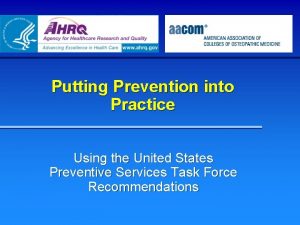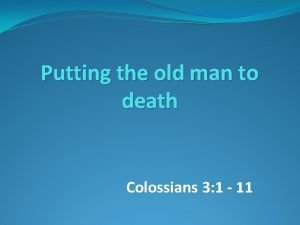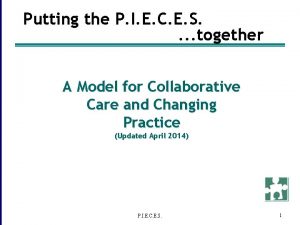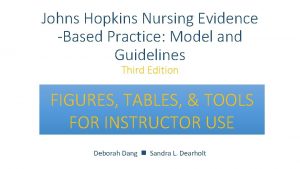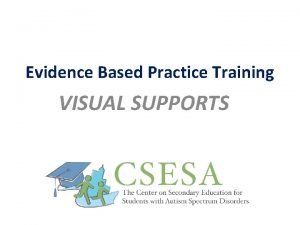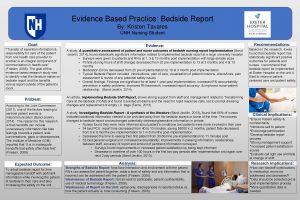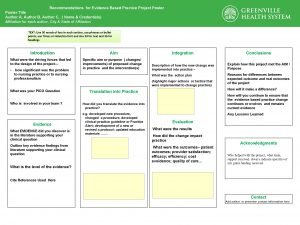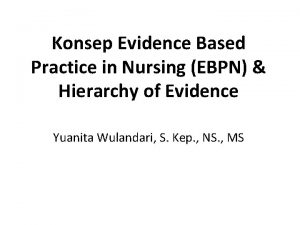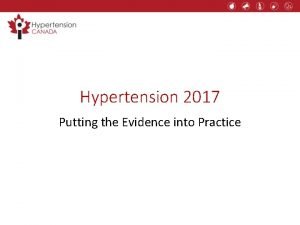Putting Evidence Into Practice Management and Prevention of


































































- Slides: 66

Putting Evidence Into Practice: Management and Prevention of Pediatric Obesity in Canada A guide to the Pediatric components of the “Canadian Clinical Practice Guidelines (CPG) on the Management and Prevention of Obesity in Adults & Children” (CMAJ 2007) Developed: Spring 2010

Purpose The purpose of these slides is to create a tool for health care practitioners that: 1. Identifies the Canadian recommendations for obesity management and prevention that are specific to the pediatric population and; 2. Provides information on how to implement each recommendation » This includes material directly from the Canadian Clinical Practice Guidelines (CPG) as well as supplementary information provided by the contributors based on their professional expertise. Management and Prevention of Pediatric Obesity in Canada 2

Slide Development Team Kathryn Ambler, MSc University of Alberta Geoff Ball, Ph. D, RD University of Alberta Tracey Bridger, MD Janeway Child Health Centre, Memorial University Sara Kirk, Ph. D Dalhousie University Katherine Morrison, MD Mc. Master University Management and Prevention of Pediatric Obesity in Canada 3

Content Experts Geoff Ball, Ph. D, RD University of Alberta Tracey Bridger, MD Janeway Child Health Centre, Memorial University JP Chanoine, MD, Ph. D British Columbia Children’s Hospital Linda Gillis, MSc, RD Mc. Master Children’s Hospital Stasia. Hadjiyannakis. BSc, MD Children's Hospital of Eastern Ontario Tracy Hussey. MSc, RD Hamilton Family Health Team Sara Kirk, Ph. D Dalhousie University Claire Le. Blanc MD, FRCPC University of Alberta Laurent Legault, MD Montreal Children's Hospital Katherine Morrison, MD Mc. Master University Zubeen. Punthakee, MD FRCPC, ABIM Mc. Master University Elizabeth Sellers MSc, MD University of Manitoba Management and Prevention of Pediatric Obesity in Canada 4

Acknowledgements Canadian Obesity Network (CON) Treatment and Research of Obesity in Pediatrics In Canada (TROPIC) Maternal, Infant, Child and Youth Research Network (MICYRN) Ashlee Pigford, University of Alberta Tarra Penney, Dalhousie University Greg Hayward, Dalhousie University Vision Creative Inc. Management and Prevention of Pediatric Obesity in Canada 5

Table of Contents 1. Pediatric Obesity in Canada: Epidemiology, Etiology and Risks 2. Role of Health Professionals: Evaluating and Managing Obesity 3. A Systematic Approach to Managing and Preventing Childhood Obesity 4. Recommendations for Managing Childhood Obesity 5. Case Study: Michael 6. Recommendations for the Prevention of Childhood Obesity 7. Summary and Conclusion Management and Prevention of Pediatric Obesity in Canada 6

Index of Recommendations 1. Role of health professionals 2. Classification of overweight and obesity in children and adolescents 3. Clinical evaluation of obese children and adolescents 4. Assessment of Readiness to Change 5. Lifestyle Modification 1. Behaviour Therapy 2. Dietary Interventions 3. Physical Activity Interventions 4. Combined Dietary and Physical Activity Interventions 5. Pharmacotherapy 6. Surgery 7. Alternative Interventions 6. Prevention: Childhood nutrition 7. Prevention: Physical Activity/Reduced Sedentary Behaviour 8. Higher level prevention strategies Management and Prevention of Pediatric Obesity in Canada 7

Management and Prevention of Pediatric Obesity in Canada 1 Pediatric Obesity in Canada: Epidemiology, Etiology and Risks

Pediatric Obesity in Canada: Epidemiology, Etiology and Risks Childhood Obesity in Canadian Children 1 9 • 3 -fold increase in obesity in Canadian children Obesity prevalence (%) 8 7 6 5 4 1979 3 2004 2 • Based on measured heights and weights in representative Canadian sample • Classified by BMI ≥ 95 th percentile 1 0 Girls Boys Shields, 2005 Management and Prevention of Pediatric Obesity in Canada 9

Pediatric Obesity in Canada: Epidemiology, Etiology and Risks Etiology 1 • Etiology for the development of obesity in childhood is complex and multifactorial • Balance of input (through nutrient intake) and output (through physical activity) is fundamental – but understanding the underpinnings of these is most important • Recognized determinants for the development of obesity occur across the lifespan – and both genetics and environment are critical Management and Prevention of Pediatric Obesity in Canada 10

Pediatric Obesity in Canada: Epidemiology, Etiology and Risks Obesity and Children’s Health Ebbeling et al. , 2002 Management and Prevention of Pediatric Obesity in Canada 1 11

Management and Prevention of Pediatric Obesity in Canada 2 Role of Health Professionals: Evaluating and Managing Obesity

Role of Health Professionals: Evaluating and Managing Obesity Recommendation: Role of Health Professionals 2 R Management and Prevention of Pediatric Obesity in Canada 13

R: Role of Health Professionals: Evaluating and Managing Obesity 2 Health care professionals are encouraged to: • Work with other health care team members to develop a comprehensive program for the patient • Create a non-judgmental atmosphere • Consider barriers people might have [grade C, levels 3 & 4] Complete Guidelines Management and Prevention of Pediatric Obesity in Canada 14

Role of Health Professionals: Evaluating and Managing Obesity Multidisciplinary Health Care Teams 2 • Can be used with individuals or with groups • Include: » Medical practitioner (Nurse, family physician or specialist) » Psychologist » Dietician » Exercise Professional » Others Management and Prevention of Pediatric Obesity in Canada 15

Role of Health Professionals: Evaluating and Managing Obesity Attitudes toward overweight and obesity 2 • Many overweight and obese people experience negative bias and discrimination • They may be reluctant to seek health care because of fear of scolding or humiliation • Stereotypes and prejudices held by health care professionals can compromise care Management and Prevention of Pediatric Obesity in Canada 16

Role of Health Professionals: Evaluating and Managing Obesity Creating a non-judgmental atmosphere SUPPLEMENTARY INFORMATION 2 • Limit medical jargon • Use neutral body language • Speak with both the child and parent • Avoid blaming Management and Prevention of Pediatric Obesity in Canada 17

Role of Health Professionals: Evaluating and Managing Obesity Considering Barriers SUPPLEMENTARY INFORMATION 2 • Focus on the family’s agenda, not your own • Seek out experienced colleagues to provide honest feedback • Increase knowledge and clinical skills through continuing education in therapeutic techniques, including motivational interviewing and cognitive behavioural therapy Management and Prevention of Pediatric Obesity in Canada 18

A Systematic Approach to Managing and Preventing Childhood Obesity 3 A Systematic Approach to Managing and Preventing Childhood Obesity

A Systematic Approach to Managing and Preventing Childhood Obesity 3 PERFORM BMI SCREENING (ALL YOUTH) If <85 th percentile If ≥ 85 th percentile TAKE MEDICAL HISTORY AND CONDUCT PHYSICAL EXAMINATION Abnormality(ies) Present Abnormality(ies) Absent TEST FOR SPECIFIC GENETIC OR ENDOCRINE CONDITIONS ASSESS READINESS TO CHANGE FOCUS ON OBESITY Individual Approaches: Policy Approaches PHYSICAL ACTIVITY Individual Approaches: NUTRITION Environmental Approaches LIFESTYLE MODIFICATION APPROPRIATE TO SITUATION FOLLOW UP Management and Prevention of Pediatric Obesity in Canada 20

Recommendations for Managing Childhood Obesity 4 Recommendations for Managing Childhood Obesity

Classification of Overweight and Obesity in Children and Adolescents Recommendations for Managing Childhood Obesity 4 PERFORM BMI SCREENING (ALL YOUTH) If ≥ 85 th percentile TAKE MEDICAL HISTORY AND CONDUCT PHYSICAL EXAMINATION Abnormality(ies) Present Abnormality(ies) Absent TEST FOR SPECIFIC GENETIC OR ENDOCRINE CONDITIONS ASSESS READINESS TO CHANGE LIFESTYLE MODIFICATION APPROPRIATE TO SITUATION FOLLOW UP Management and Prevention of Pediatric Obesity in Canada 22

Recommendations for Managing Childhood Obesity Recommendation: BMI Screening 4 R Management and Prevention of Pediatric Obesity in Canada 23

R: BMI Screening Recommendations for Managing Childhood Obesity 4 We recommend: • measuring BMI in all children and adolescents (aged 2 years and older). • using the growth charts of the US Centers for Disease Control and Prevention to screen for overweight and obesity » Overweight: Age and sex-specific BMI ≥ 85 th and <95 th percentile » Obesity: Age and sex-specific BMI ≥ 95 th percentile [grade A, levels 3] Complete Guidelines Management and Prevention of Pediatric Obesity in Canada 24

Recommendations for Managing Childhood Obesity Measuring Height and Weight in Children 4 Height • Should be measured to the nearest centimetre using a stadiometer. • The patient should look straight ahead, stand as tall as possible and take a deep breath while the measurement is taken. Weight • Should be measured to the nearest 0. 1 kg with an accurate, well-maintained physician’s scale. • The patient should be weighed in light clothing, without footwear. Management and Prevention of Pediatric Obesity in Canada 25

BMI Charts for Children Recommendations for Managing Childhood Obesity (US Center for Disease Control & Prevention, CDC) Available online at: www. cdc. gov/growthcharts Management and Prevention of Pediatric Obesity in Canada 4 26

Recommendations for Managing Childhood Obesity Other Classification Systems SUPPLEMENTARY INFORMATION 4 • Other resources are available for categorizing children and youth into different BMI groups. » International Obesity Task Force (Cole et al. , 2000) » WHO Growth Curves (http: //www. who. int/childgrowth/en/) • Waist Circumference » Among children and adolescents, waist circumference is a good predictor of other measures of adiposity and risk level for heart disease. » Further research is required to determine the clinical utility of waist circumference and its association with health risks independent of BMI. Management and Prevention of Pediatric Obesity in Canada 27

Clinical Evaluation of Obese Children and Adolescents Recommendations for Managing Childhood Obesity 4 PERFORM BMI SCREENING (ALL YOUTH) If ≥ 85 th percentile TAKE MEDICAL HISTORY AND CONDUCT PHYSICAL EXAMINATION Abnormality(ies) Present Abnormality(ies) Absent TEST FOR SPECIFIC GENETIC OR ENDOCRINE CONDITIONS ASSESS READINESS TO CHANGE LIFESTYLE MODIFICATION APPROPRIATE TO SITUATION FOLLOW UP Management and Prevention of Pediatric Obesity in Canada 28

Recommendations for Managing Childhood Obesity Recommendation: Clinical Evaluation 4 R Management and Prevention of Pediatric Obesity in Canada 29

R: Clinical Evaluation Recommendations for Managing Childhood Obesity 4 We recommend that: • The clinical evaluation of overweight and obese children include a history and a general physical examination to exclude: » Secondary causes (endocrine-or syndrome-related) » Obesity-related health risks and complications [grade A, levels 3] • In overweight or obese children, a fasting plasma glucose and lipid profile should be performed in those ≥ 10 years of age Complete Guidelines [grade B, levels 3] Management and Prevention of Pediatric Obesity in Canada 30

Recommendations for Managing Childhood Obesity 4 R Recommendation: Clinical Evaluation 1. Identification of risk factors for the development of obesity Management and Prevention of Pediatric Obesity in Canada 31

Recommendations for Managing Childhood Obesity Medical History 4 • Does past Family History include obesity and obesity related disorders? • Does pregnancy history include maternal diabetes, pregnancy exposures or low birthweight • What was infant feeding history? Management and Prevention of Pediatric Obesity in Canada 32

Recommendations for Managing Childhood Obesity Additional Medical History Considerations SUPPLEMENTARY INFORMATION 4 • What is the child’s developmental history? • Does medical history include growth delay, asthma, or treatment for previous childhood cancer? • What is the pattern of weight gain? • Psychosocial history » Screen for depression and eating disorders » Assess quality of life • Past or current medications Management and Prevention of Pediatric Obesity in Canada 33

Recommendations for Managing Childhood Obesity Physical Activity and Nutrition 4 • Patterns of Physical Activity » Time spent watching television, using the computer and playing video games » Low participation in physical activities • Nutritional Intake » High sugared drink intake » Low fruit and vegetable intake » Disordered eating patterns Management and Prevention of Pediatric Obesity in Canada 34

Recommendations for Managing Childhood Obesity Physical Activity Considerations SUPPLEMENTARY INFORMATION 4 Physical Activities • • • Frequency (minutes per day) Weekdays vs. weekends Seasonal variation Type of activities (level of moderate to vigorous physical activity) With whom (friends, family, alone) Sedentary Activities • Total screen time » Television – Average per day – Is there a TV in the bedroom? » Leisure time computer and video games – Average per day – Active video games (Wii, Dance Revolution) Management and Prevention of Pediatric Obesity in Canada 35

Recommendations for Managing Childhood Obesity Nutritional Intake Considerations SUPPLEMENTARY INFORMATION 4 • Can be assessed using a 24 hour recall (or typical day recall) and/or a food frequency questionnaire • Nutritional Patterns – what is the frequency of: » » Eating meals together as a family? Eating fast food/eating out? Eating in front of the TV? Eating breakfast? Management and Prevention of Pediatric Obesity in Canada 36

Recommendations for Managing Childhood Obesity Other Considerations SUPPLEMENTARY INFORMATION 4 • Sleeping patterns • Mental health of all family members • Psychosocial family dynamics • Socioeconomics • Environment factors (home / school / community) Management and Prevention of Pediatric Obesity in Canada 37

Recommendations for Managing Childhood Obesity 4 R Recommendation: Clinical Evaluation 2. Exclusion of Secondary Causes of Obesity Management and Prevention of Pediatric Obesity in Canada 38

Recommendations for Managing Childhood Obesity Secondary Causes of Obesity 4 • Endocrine causes » associated with attenuated linear growth or a history of central nervous system injury • Genetic syndromes » usually early onset » often associated with neurodevelopmental delay » may be associated with dysmorphic features Management and Prevention of Pediatric Obesity in Canada 39

Recommendations for Managing Childhood Obesity Overview of History and Physical Exam for an Overweight or Obese Child: evaluation of genetic or endocrine causes 4 History (personal and family) Physical Exam Absence of Dysmorphic features Assessment of Growth Velocity Abnormal Possible Endocrine Disorder: Rule out hypothyroidism, GH deficiency, and Cushings Presence of Dysmorphic features Chromosomal typing, molecular biology Normal Exogenous, primary, “simple” obesity Management and Prevention of Pediatric Obesity in Canada 40

Recommendations for Managing Childhood Obesity 4 R Recommendation: Clinical Evaluation 3. Physical Exam and Identification of Obesity Related Co-morbities Management and Prevention of Pediatric Obesity in Canada 41

Recommendations for Managing Childhood Obesity Aspects of the Physical Exam SUPPLEMENTARY INFORMATION 4 In addition to measuring height and weight and calculating BMI, the physical exam may investigate: • • Blood pressure Presence of acanthosisnigricans Hirsutism and excessive acne (females) Orthopedic concerns Management and Prevention of Pediatric Obesity in Canada 42

Recommendations for Managing Childhood Obesity Recommended Laboratory Investigations 4 For children 10 years old and older: • • • Fasting plasma glucose Total cholesterol LDL cholesterol HDL: total cholesterol Management and Prevention of Pediatric Obesity in Canada 43

Recommendations for Managing Childhood Obesity Suggested Laboratory Investigations SUPPLEMENTARY INFORMATION 4 • Oral Glucose Tolerance Test • ALT and AST • Alkaline phosphatase • Albumin • Creatinine • Free testosterone, luteinizing hormone, and follicle stimulating hormone (females) Management and Prevention of Pediatric Obesity in Canada 44

Recommendations for Managing Childhood Obesity Related Co-Morbities 4 Many of the obesity-related comorbidities recognized in adulthood begin to develop in childhood: • • Cardiovascular (hypertension) Metabolic (dyslipidemia, dysglycemia, type 2 diabetes) Respiratory (obstructive sleep apnea) Gastrointestinal (nonalcoholic fatty liver disease, cholelithiasis, gastroesophageal reflux) Orthopedic (slipped capital femoral epiphysis, tibia vara [Blount disease], musculoskeletal discomfort) Reproductive (polycystic ovary syndrome) Psychosocial (poor self-esteem, depression) Renal (focal segmental glomerulosclerosis) Management and Prevention of Pediatric Obesity in Canada 45

Recommendations for Managing Childhood Obesity Determination of Obesity Related Co-morbities Obesity related health consequence 4 Recommended assessment Hypertension Serial blood pressure measurements Obstructive sleep apnea Hx: snoring, am headache, excess daytime fatigue, Consider sleep study Nonalcoholic fatty liver disease (NAFLD) History, physical exam, ALT & AST levels Gastroesophageal reflux History Gallstones History, laboratory Management and Prevention of Pediatric Obesity in Canada 46

Recommendations for Managing Childhood Obesity Determination of Obesity Related Co-morbities Obesity related health consequence 4 Recommended assessment Slipped capital femoral epiphysis History, Physical Tibia vara (Blount’s disease) History, Physical Spondylolisthesis History, physical exam Axial arthritis History Polycystic ovary syndrome History(menstrual irregularity, 2º amenorrhea) Physical (hirsutism, acne) Laboratory (LH, FSH, free testosterone, pelvic ultrasound) Depression History Low self-esteem History Binge-eating disorder History Management and Prevention of Pediatric Obesity in Canada 47

Recommendations for Managing Childhood Obesity Determination of Obesity Related Co-morbities 4 Diabetes screening: • For children ≥ 10 years if they have 2 of the following risk factors: » » » member of a high-risk ethnic group family history of type 2 diabetes (especially if the child was exposed to diabetes in utero) acanthosisnigricans polycystic ovarian syndrome hypertension dyslipidemia • Should be done every 2 years using a fasting plasma glucose test. » An oral glucose tolerance test may also be considered as a screening test. Management and Prevention of Pediatric Obesity in Canada 48

Recommendations for Managing Childhood Obesity Assessment of Readiness to Change 4 PERFORM BMI SCREENING (ALL YOUTH) If ≥ 85 th percentile TAKE MEDICAL HISTORY AND CONDUCT PHYSICAL EXAMINATION Abnormality(ies) Present Abnormality(ies) Absent TEST FOR SPECIFIC GENETIC OR ENDOCRINE CONDITIONS ASSESS READINESS TO CHANGE LIFESTYLE MODIFICATION APPROPRIATE TO SITUATION FOLLOW UP Management and Prevention of Pediatric Obesity in Canada 49

Recommendations for Managing Childhood Obesity Recommendation: Readiness to Change 4 R Management and Prevention of Pediatric Obesity in Canada 50

R: Readiness to Change Recommendations for Managing Childhood Obesity 4 • Assess readiness and barriers to change before implementing a healthy lifestyle plan for weight control or management [grade B, levels 3] Complete Guidelines Management and Prevention of Pediatric Obesity in Canada 51

Recommendations for Managing Childhood Obesity Readiness to Change 4 • Specific to individual behaviours • Can be influenced by temporal, environmental and social factors. • Represented by the stages of change categories: » » » Precontemplation Contemplation Preparation Action Maintenance Pre-action stages Action stages Management and Prevention of Pediatric Obesity in Canada 52

Recommendations for Managing Childhood Obesity Other Factors Influencing Change 4 • Decisional balance: the pros and cons of performing a healthy behaviour • Specific barriers to performing the healthy behaviour • Temptations to not perform the healthy behaviour Management and Prevention of Pediatric Obesity in Canada 53

Recommendations for Managing Childhood Obesity Barriers to Change 4 Include but are not limited to: • Reluctance to seek medical attention • Depression or other psychosocial barriers • Low or lacking self-efficacy Management and Prevention of Pediatric Obesity in Canada 54

Recommendations for Managing Childhood Obesity Clinical Evaluation of Obese Children and Adolescents 4 PERFORM BMI SCREENING (ALL YOUTH) If ≥ 85 th percentile TAKE MEDICAL HISTORY AND CONDUCT PHYSICAL EXAMINATION Abnormality(ies) Present Abnormality(ies) Absent TEST FOR SPECIFIC GENETIC OR ENDOCRINE CONDITIONS ASSESS READINESS TO CHANGE LIFESTYLE MODIFICATION APPROPRIATE TO SITUATION FOLLOW UP Management and Prevention of Pediatric Obesity in Canada 55

Recommendations for Managing Childhood Obesity Recommendation: Lifestyle Modification 4 R Management and Prevention of Pediatric Obesity in Canada 56

R: Lifestyle Modification Recommendations for Managing Childhood Obesity 4 • We recommend a comprehensive healthy lifestyle intervention for overweight and obese people [grade A, levels 1] • We suggest that members of the health care team discuss with those willing to participate in weight management programs appropriate education, support and therapy as adjuncts to lifestyle intervention [grade B, levels 2] Complete Guidelines Management and Prevention of Pediatric Obesity in Canada 57

Recommendations for Managing Childhood Obesity Recommendation: Behaviour Therapy 4 R Management and Prevention of Pediatric Obesity in Canada 58

R: Behaviour Therapy Recommendations for Managing Childhood Obesity 4 • We suggest that individuals willing to participate in weight management programs be provided with education and support in behaviour modification techniques as an adjunct to other interventions [grade B, levels 2] • When treating obesity in children, we suggest using family-oriented behaviour therapy [grade B, levels 1] Complete Guidelines Management and Prevention of Pediatric Obesity in Canada 59

Recommendations for Managing Childhood Obesity Motivational Interviewing 4 • The goal of MI is NOT to get the patient to change but to facilitate motivation • Key principles (from Miller and Rollnick): » » Express empathy Develop discrepancy Roll with resistance Support self-efficacy/confidence Management and Prevention of Pediatric Obesity in Canada 60

Recommendations for Managing Childhood Obesity Motivational Interviewing 4 Guided by the 6 mediators of change (FRAMES mnemonic): 1. Feedback of personal risk or impairment 2. Emphasis on personal Responsiblity for change 3. Clear Advice to change 4. A Menu of alternative change options 5. Therapist Empathy 6. Facilitation of client Self-efficacy or optimism Management and Prevention of Pediatric Obesity in Canada 61

Recommendations for Managing Childhood Obesity Behaviour Modification Techniques 4 • Self monitoring and goal setting » Tracking and analyzing precipitants, consequences and moderating factors to set goals for change • Stimulus control » Identifying stimuli (situations, times, people, emotions) that elicit unhealthy behaviour • Reinforcement management » Rewarding specific behaviour change Management and Prevention of Pediatric Obesity in Canada 62

Recommendations for Managing Childhood Obesity Behaviour Change Principles SUPPLEMENTARY INFORMATION 4 • Use a long term approach • Work towards changes that are achievable and sustainable • Focus on the priorities of the family • Avoid scare tactics • Identify potential barriers and enablers to behaviour change Management and Prevention of Pediatric Obesity in Canada 63

Recommendations for Managing Childhood Obesity Goal Setting SUPPLEMENTARY INFORMATION 4 • Goal-setting with family should be centered around change in behaviour – not weight • A modest weight loss of 5– 10% body weight is beneficial • In growing child, weight maintenance equivalent to weight loss • Weight maintenance and prevention of weight regain should be considered long-term goals Management and Prevention of Pediatric Obesity in Canada 64

Recommendations for Managing Childhood Obesity SMART Goal Setting 4 • SMART goals are: » Specific: You can answer when, where, what, and how » Measureable: You know if it’s done » Attainable: It’s possible for you to do » Relevant: The goal is important to you » Time-specific: Set a time limit for achieving you goals Management and Prevention of Pediatric Obesity in Canada 65

Recommendations for Managing Childhood Obesity Role of Families in Behaviour Change SUPPLEMENTARY INFORMATION 4 • Recognize that parents play a fundamental role in weight management • Use a family-centred approach – talk with both the child and the family • Focus on helping the whole family to become healthier, not ‘fixing’ the individual child Management and Prevention of Pediatric Obesity in Canada 66
 Putting prevention into practice
Putting prevention into practice Putting evidence into nursing practice
Putting evidence into nursing practice Primary prevention secondary prevention tertiary prevention
Primary prevention secondary prevention tertiary prevention Price fences marketing
Price fences marketing Putting it into practice
Putting it into practice Coherent curriculum
Coherent curriculum Putting the enterprise into the enterprise system
Putting the enterprise into the enterprise system Putting the enterprise into the enterprise system
Putting the enterprise into the enterprise system Practice putting it all together
Practice putting it all together Explain how class evidence may be useful
Explain how class evidence may be useful What is a primary source
What is a primary source Primary evidence vs secondary evidence
Primary evidence vs secondary evidence Secondary sources
Secondary sources Primary evidence vs secondary evidence
Primary evidence vs secondary evidence Primary evidence vs secondary evidence
Primary evidence vs secondary evidence Are fibers class evidence
Are fibers class evidence Class evidence vs individual evidence
Class evidence vs individual evidence Individual vs class evidence
Individual vs class evidence Amphiboly fallacy
Amphiboly fallacy Theory research and evidence based practice
Theory research and evidence based practice Evidence based theory
Evidence based theory Effective teaching evidence and practice
Effective teaching evidence and practice Evidence and elaboration practice
Evidence and elaboration practice Putting-out system
Putting-out system What does nasreen say about ice cream with chocolate
What does nasreen say about ice cream with chocolate When was the loom invented
When was the loom invented Putting-out system
Putting-out system After putting the pieces together what do they look like
After putting the pieces together what do they look like Putting objects in perspective
Putting objects in perspective The order of putting on ppe
The order of putting on ppe Putting it all together motion answer key
Putting it all together motion answer key Ordering fractions with different denominators
Ordering fractions with different denominators Putting people first 2007
Putting people first 2007 Putting-out system
Putting-out system Classify each polynomial according to its degree and type.
Classify each polynomial according to its degree and type. Letters put together
Letters put together Sculpture is created by shaping or combining the materials
Sculpture is created by shaping or combining the materials Putting zone
Putting zone Putting to death the old man
Putting to death the old man Putting stance width
Putting stance width Putting a package together
Putting a package together The spatial strategy of organizing your speech
The spatial strategy of organizing your speech Putting on the new man
Putting on the new man Putting two words together
Putting two words together Why we all have
Why we all have 6x²y³÷xy²= _______.
6x²y³÷xy²= _______. Putting it all to bed during project closeout includes
Putting it all to bed during project closeout includes Putting the pieces together case study answer key
Putting the pieces together case study answer key Putting things together is called
Putting things together is called Principles of evidence based practice
Principles of evidence based practice John hopkins evidence-based practice model
John hopkins evidence-based practice model Evidence based practice topics
Evidence based practice topics Decision making venn diagram
Decision making venn diagram Visual supports evidence based practice
Visual supports evidence based practice Evidence-based practice bedside shift report
Evidence-based practice bedside shift report Iowa model of evidence-based practice diagram
Iowa model of evidence-based practice diagram The seven steps of evidence-based practice
The seven steps of evidence-based practice Qsen safety competencies examples
Qsen safety competencies examples Three legged stool evidence based practice
Three legged stool evidence based practice Evidence based practice poster template
Evidence based practice poster template Evidence-based practice orem's theory
Evidence-based practice orem's theory Klinisch redeneren dobber
Klinisch redeneren dobber Evidence based practice adalah
Evidence based practice adalah Ebm hierarchy
Ebm hierarchy Apa presidential task force on evidence-based practice
Apa presidential task force on evidence-based practice Reflectieve ebp professional
Reflectieve ebp professional Klinisch redeneren en evidence-based practice
Klinisch redeneren en evidence-based practice
